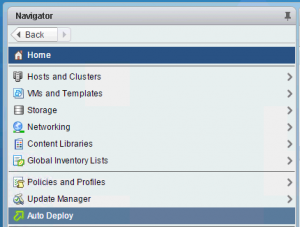I ran into a problem with VMware vSphere 6.5 Auto Deploy suddenly stopped working.
When trying to change rules with New-DeployRule or Repair-DeployImageCache I got the following error:
Repair-DeployImageCache
System.Runtime.Serialization.SerializationException: Parse Error, no assembly associated with Xml key ImagefactoryPkgImageProfile
at System.Runtime.Serialization.Formatters.Soap.SoapHandler.ProcessGetType(String value, String xmlKey, String& assemblyString)
at System.Runtime.Serialization.Formatters.Soap.SoapHandler.ProcessType(ParseRecord pr, ParseRecord objectPr)
at System.Runtime.Serialization.Formatters.Soap.SoapHandler.ProcessAttributes(ParseRecord pr, ParseRecord objectPr)
at System.Runtime.Serialization.Formatters.Soap.SoapHandler.StartChildren()
at System.Runtime.Serialization.Formatters.Soap.SoapParser.ParseXml()
at System.Runtime.Serialization.Formatters.Soap.SoapParser.Run()
at System.Runtime.Serialization.Formatters.Soap.ObjectReader.Deserialize(HeaderHandler handler, ISerParser serParser)
at System.Runtime.Serialization.Formatters.Soap.SoapFormatter.Deserialize(Stream serializationStream, HeaderHandler handler)
at VMware.DeployAutomation.Types.PxeProfile.get_ImageProfile()
System.Runtime.Serialization.SerializationException: Parse Error, no assembly associated with Xml key ImagefactoryPkgImageProfile
at System.Runtime.Serialization.Formatters.Soap.SoapHandler.ProcessGetType(String value, String xmlKey, String& assemblyString)
at System.Runtime.Serialization.Formatters.Soap.SoapHandler.ProcessType(ParseRecord pr, ParseRecord objectPr)
at System.Runtime.Serialization.Formatters.Soap.SoapHandler.ProcessAttributes(ParseRecord pr, ParseRecord objectPr)
at System.Runtime.Serialization.Formatters.Soap.SoapHandler.StartChildren()
at System.Runtime.Serialization.Formatters.Soap.SoapParser.ParseXml()
at System.Runtime.Serialization.Formatters.Soap.SoapParser.Run()
at System.Runtime.Serialization.Formatters.Soap.ObjectReader.Deserialize(HeaderHandler handler, ISerParser serParser)
at System.Runtime.Serialization.Formatters.Soap.SoapFormatter.Deserialize(Stream serializationStream, HeaderHandler handler)
at VMware.DeployAutomation.Types.PxeProfile.get_ImageProfile()
System.Runtime.Serialization.SerializationException: Parse Error, no assembly associated with Xml key ImagefactoryPkgImageProfile
at System.Runtime.Serialization.Formatters.Soap.SoapHandler.ProcessGetType(String value, String xmlKey, String& assemblyString)
at System.Runtime.Serialization.Formatters.Soap.SoapHandler.ProcessType(ParseRecord pr, ParseRecord objectPr)
at System.Runtime.Serialization.Formatters.Soap.SoapHandler.ProcessAttributes(ParseRecord pr, ParseRecord objectPr)
at System.Runtime.Serialization.Formatters.Soap.SoapHandler.StartChildren()
at System.Runtime.Serialization.Formatters.Soap.SoapParser.ParseXml()
at System.Runtime.Serialization.Formatters.Soap.SoapParser.Run()
at System.Runtime.Serialization.Formatters.Soap.ObjectReader.Deserialize(HeaderHandler handler, ISerParser serParser)
at System.Runtime.Serialization.Formatters.Soap.SoapFormatter.Deserialize(Stream serializationStream, HeaderHandler handler)
at VMware.DeployAutomation.Types.PxeProfile.get_ImageProfile()
System.Runtime.Serialization.SerializationException: Parse Error, no assembly associated with Xml key ImagefactoryPkgImageProfile
at System.Runtime.Serialization.Formatters.Soap.SoapHandler.ProcessGetType(String value, String xmlKey, String& assemblyString)
at System.Runtime.Serialization.Formatters.Soap.SoapHandler.ProcessType(ParseRecord pr, ParseRecord objectPr)
at System.Runtime.Serialization.Formatters.Soap.SoapHandler.ProcessAttributes(ParseRecord pr, ParseRecord objectPr)
at System.Runtime.Serialization.Formatters.Soap.SoapHandler.StartChildren()
at System.Runtime.Serialization.Formatters.Soap.SoapParser.ParseXml()
at System.Runtime.Serialization.Formatters.Soap.SoapParser.Run()
at System.Runtime.Serialization.Formatters.Soap.ObjectReader.Deserialize(HeaderHandler handler, ISerParser serParser)
at System.Runtime.Serialization.Formatters.Soap.SoapFormatter.Deserialize(Stream serializationStream, HeaderHandler handler)
at VMware.DeployAutomation.Types.PxeProfile.get_ImageProfile()
Continue reading VMware Auto Deploy stopped working with Parse Error

